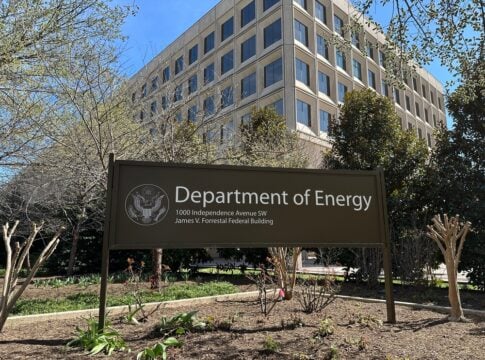Energy is the cornerstone of modern life. We need electricity for healthcare, transportation, communication, and more. Many countries are choosing nuclear power because it offers a lot of electricity and produces no direct carbon dioxide emissions. However, building traditional nuclear plants is costly. They can take a long time to set up, and people often doubt their safety.
Small Modular Reactors (SMRs) offer a potential way forward. SMRs aim to deliver safe, reliable, and clean electricity. They do this by shrinking reactor size and standardizing construction. This approach reduces the risks and costs tied to traditional nuclear plants.
If you’re looking for a one-stop resource on SMRs—complete with technical details, key players, regulatory considerations, and future trends—this guide is for you.
Table of Contents
- 1. What is a Small Modular Reactor?
- 2. How Is Nuclear Power Shaping Global Energy Consumption?
- 3. Nuclear as a Cleaner and Safer Energy Source
- 4. What Does the Future Hold for Nuclear Energy?
- 5. How Do SMRs Work?
- 6. Advantages of SMRs
- 7. Regulatory & Permit Process for SMRs
- 8. Challenges Facing SMRs
- 9. Leading SMR Projects and Technologies Under Construction
- 10. SMRs and Big Tech Companies: The Future of Data Centers and AI
- 11. SMRs and Carbon Credits
- 12. The Future of SMRs
- 13. Conclusion
- 14. Key Takeaways
What is a Small Modular Reactor?
A Small Modular Reactor is a nuclear reactor with an electric output of up to 300 megawatts (MWe) per unit. Unlike traditional reactors that exceed 1,000 MWe, engineers design SMRs as modular systems, factory-building components for faster assembly. This method can cut down on construction time and costs, all while keeping safety standards high.
The International Atomic Energy Agency (IAEA) says that SMRs are promising. They can fit into different power grids, provide both electricity and heat, and serve countries with smaller energy needs. They also appeal to developed nations seeking to replace aging reactors or achieve net-zero targets with minimal risk.
Why Are SMRs Important?
With global warming on the rise, many nations must find ways to supply affordable, low-carbon electricity. Large nuclear plants can take well over a decade to build, cost billions of dollars, and face social and political challenges. SMRs, on the other hand, promise:
- Faster Deployment: Factory assembly can shorten construction timelines.
- Lower Financial Risk: Smaller plants mean smaller capital outlays and potentially lower financing costs.
- Flexibility: SMRs can serve remote areas, industrial sites, or developing regions without robust grids.
In short, SMRs bridge the gap between large nuclear plants and renewable energy, offering steady, carbon-free power that can support solar and wind during periods of low sunlight or wind.
But before we dive into the SMR details, it helps to have a broader picture of the nuclear energy landscape and know the trends that led to the rise of SMRs.
How Is Nuclear Power Shaping Global Energy Consumption?
Nuclear energy has been a critical part of the world’s power supply for decades. Today, it provides about 10% of global electricity, with over 400 reactors operating in more than 30 countries.
Countries Leading in SMR Development and Deployment
The U.S. (with 22 designs), Russia (17), China (10), Canada (5), and the UK (4) lead SMR development and deployment. They have significant investments and government-backed projects. Over 80 SMR designs are currently under development in 18 countries.
Some countries, such as France, depend on nuclear power for over 70% of their electricity. The United States and China are also increasing their nuclear capacity. They want to rely less on fossil fuels.

Compared to fossil fuel plants, nuclear power plants operate at a higher capacity factor. This means they produce electricity more efficiently and consistently.
While coal and natural gas plants may run at about 50–60% capacity, nuclear plants often reach 90% or higher. This makes nuclear energy one of the most reliable sources of electricity in the world.
Growth in Nuclear Power Use
As the world shifts toward cleaner energy, nuclear power is becoming more important. In 2023, nuclear power plants worldwide generated around 2,600 terawatt-hours (TWh) of electricity.
The demand for electricity continues to rise, and countries are prioritizing nuclear energy as a reliable solution. Countries such as the USA and China are leading nuclear expansion efforts, with multiple reactors under construction.
Top Countries by Nuclear Energy Supply and Consumption in 2023

Source: International Atomic Energy Agency
Some countries are rethinking their nuclear investments. Germany, for example, closed its last nuclear plants in 2023. But now, rising energy costs and supply worries have sparked talks about restarting nuclear programs.
Global SMR Tracker: Monitoring Small Modular Reactor Development
For stakeholders tracking the rapid evolution of small modular reactors, the World Nuclear Association’s SMR Global Tracker serves as the definitive resource for real-time insights. Updated in January 2025, this tool provides:
- Comprehensive Coverage: 80+ SMR designs across 18 countries, including the U.S., China, Russia, and Canada.
- Development Stages: Filters for conceptual, licensed, and operational projects (e.g., NuScale’s Idaho pilot, Russia’s RITM-200M deployments).
- Technical Specifications: Reactor type (PWR, molten salt, gas-cooled), capacity (1–300 MWe), and coolant systems.
- Market Trends: Growth metrics like the 120 GW global SMR capacity target by 2050 under IEA’s net-zero scenarios.

Nuclear as a Cleaner and Safer Energy Source
One of the biggest advantages of nuclear power is that it is a low-carbon energy source. Unlike coal and natural gas, nuclear reactors do not produce greenhouse gas emissions during operation.
According to the International Energy Agency (IEA), nuclear energy prevents over 2 billion metric tons of CO2 emissions annually. This makes nuclear power an essential tool in the fight against climate change.
Carbon Emissions Comparison
Compared to fossil fuels, nuclear energy has a much lower carbon footprint. The lifecycle emissions of nuclear power—accounting for mining, fuel processing, construction, and decommissioning—are estimated at about 12 grams of CO₂ per kilowatt-hour (gCO₂/kWh). In contrast:
- Coal: Around 820 gCO₂/kWh
- Natural gas: Around 490 gCO₂/kWh
- Solar: Between 40-50 gCO₂/kWh (mainly from production)
- Wind: Around 10-12 gCO₂/kWh

Source: World Nuclear Association
Safety Improvements
Nuclear energy often gets a bad rap for its perceived dangers. However, statistics reveal a different story: it’s one of the safest energy sources around! According to the World Health Organization (WHO), nuclear power results in fewer deaths per energy unit than coal, oil, or biomass. The numbers paint a picture of safety that defies common belief.
In particular, coal mining results in thousands of deaths each year due to lung diseases, explosions, and accidents. In contrast, nuclear energy has caused fewer fatalities. This makes it a much safer option for energy production.
Modern nuclear reactors include many safety features. They have passive cooling systems and automated shutdown mechanisms to prevent accidents. Past nuclear incidents like Chernobyl and Fukushima drove regulators to mandate safer reactor designs.

How SMRs Compare to Renewables in Cost and Reliability
SMRs provide consistent, 24/7 baseload power, unlike solar and wind, which depend on weather conditions. Solar and wind energy can be cheaper, costing $20–$50/MWh. However, SMRs provide long-term reliability. This makes them great for stabilizing the grid.
But, the cost-effectiveness and feasibility of SMRs are still unclear. Initial estimates show they might cost more than regular reactors.
What Does the Future Hold for Nuclear Energy?
The future of nuclear energy looks strong. Many governments view this as a way to tackle climate change and ensure energy security. Currently, around 80 reactors are being built globally.
The IEA predicts that nuclear capacity will need to double by 2050 to meet global climate goals. The World Nuclear Association says nuclear capacity could hit 800 gigawatts (GW) worldwide by 2050. That’s double the roughly 400 GW we have today.
Several countries are investing heavily in nuclear energy:
- China plans to add 150 new reactors by 2050.
- India aims to increase its nuclear capacity from 7 gigawatts (GW) to 22 GW by 2031.
- United States is supporting advanced nuclear projects and extending the lifespan of existing reactors.
- Russia proposes constructing 34 new nuclear reactors by 2042, aiming to add about 28 GW.
Investment in Nuclear Technologies
The U.S. Department of Energy (DOE) is putting in $3.2 billion. This money will help create next-generation reactors, such as SMRs and Advanced Nuclear Reactors (ANRs). Of this, $1.2 billion will fund the Advanced Reactor Demonstration Program (ARDP). This program aims to have two fully operational advanced reactors by the late 2020s.
One major beneficiary is TerraPower, a Bill Gates-backed company. It received $2 billion in funding for its Natrium reactor project in Wyoming. This project features a 345-megawatt (MW) sodium-cooled fast reactor. It could increase output to 500 MW when paired with its thermal energy storage system.
Outside the U.S., countries like Canada and the UK are also ramping up investments.
Canada’s Strategic Innovation Fund will invest $970 million in Ontario Power Generation’s SMR project. Meanwhile, the UK government has committed £1.7 billion ($2.1 billion) to Rolls-Royce for SMR development.
These investments show a strong belief in nuclear technology. It will be an important part of future energy systems.
Notably, global investment in nuclear energy is set to rise. Right now, it’s about $65 billion each year. By 2030, it could hit $70 billion with current policies. Nuclear capacity is expected to grow by over 50% to nearly 650 GW by 2050.

With stronger government actions, investment could go even higher. In the Announced Pledges Scenario (APS), if we fully apply energy and climate policies, investment may hit $120 billion by 2030. Also, nuclear capacity would more than double by mid-century.
In the Net Zero Emissions by 2050 scenario, investment might top $150 billion by 2030. Capacity could exceed 1,000 GW by 2050.
Large reactors lead the way in investment. However, Small Modular Reactors (SMRs) are growing fast. Under APS, over 1,000 SMRs will be deployed by 2050, with a total capacity of 120 GW. Investment in SMRs will jump from $5 billion today to $25 billion by 2030.
Investment Trends: The Case for SMRs
Cost-competitive small modular reactors could change the nuclear energy scene. Government support and new business models back this shift. There’s strong interest in SMRs due to the need for reliable, clean power, especially from data centers. Current plans aim for up to 25 GW of SMR capacity, with hopes for 40 GW by 2050 under current policies.
With better policy support and simpler regulations, SMR capacity could reach 120 GW by mid-century. This would need more than 1,000 SMRs. This growth would need a big investment jump from $5 billion today to $25 billion by 2030, totaling $670 billion by 2050.
If SMR construction costs drop to match large reactors in 15 years, capacity might hit 190 GW by 2050. This could spark $900 billion in global investment.

SMRs, along with efficient large-scale reactors, can help Europe, the US, and Japan lead in nuclear technology again. By 2050, nuclear capacity in advanced economies might grow by over 40%, aiding energy security and emissions targets.
So, what exactly are these SMRs and why are they changing the future of the nuclear energy landscape?
- Click here for live URANIUM prices.
How Do SMRs Work?
Nuclear reactors produce heat by nuclear fission. As it is shown in the following image, uranium fuel undergoes a chain reaction where uranium atoms split, releasing energy in the form of heat and neutrons. Water or another coolant absorbs this heat and turns it into steam. The steam then drives a turbine connected to a generator, producing electricity.

Modular Construction
The distinctive feature of SMRs is their modular design. Companies create key parts such as reactor vessels, steam generators, and control systems in specialized factories. Then, these modules are shipped to the installation site. Workers assemble them like Lego blocks.
This approach offers several advantages:
- Quality Control: Factory settings can adhere to strict standards, reducing on-site errors.
- Faster Assembly: On-site construction primarily involves connecting pre-built modules, speeding up timelines.
- Scalability: Utilities can start with one module and add more as energy demand grows.

Advanced Safety Features
Most small modular reactors rely on passive safety systems. This means they can shut down or cool themselves without relying on human intervention or external power:
- Gravity-Driven Coolant: If the reactor overheats, gravity pulls cool water into the core.
- Smaller Cores: Less radioactive material means lower risk in worst-case scenarios.
- Underground or Submerged Designs: Placing reactors below ground adds a natural barrier against external hazards.
Such features not only lower the probability of a major incident but also help ease public concerns about nuclear safety.
Fuel Variants
While most SMRs use low-enriched uranium (LEU) at about 3-5% enrichment, some advanced designs plan for high-assay low-enriched uranium (HALEU) (up to 20% enrichment) or molten salt fuel for enhanced efficiency.
A handful of cutting-edge concepts even explore thorium or gas-cooled reactors, aiming to reduce radioactive waste and improve thermal performance.
How SMRs Tackle Nuclear Waste Disposal
SMRs create less waste. They might also use advanced fuel cycles. For example, they can recycle spent fuel or use molten salt reactors that can cut down long-term storage needs. These innovations aim to minimize environmental impact.
Advantages of SMRs
As already mentioned earlier, small modular reactors offer a lot of benefits that make them attractive to both developers and investors alike. Here are the major advantages this nuclear technology provides:
-
Lower Carbon Footprint
Nuclear reactors produce electricity without direct carbon emissions. By substituting coal or natural gas plants with SMRs, utilities can significantly cut greenhouse gases. In many countries, nuclear power already forms a large portion of low-carbon energy, and SMRs could expand that share even more.
-
Scalability and Grid Flexibility
One major selling point of SMRs is scalability. Instead of committing to a massive reactor from day one, utilities can build capacity module by module. This flexibility suits:
- Remote or Island Grids: Places relying on expensive diesel shipments can switch to SMRs for long-term reliability.
- Growing Economies: Rapidly expanding regions can add SMR modules to match rising demand.
- Distributed Power: Several smaller reactors scattered throughout a region can help balance the grid, reducing transmission bottlenecks.
SMRs work well in remote areas, but some can be used in cities too. They come with added safety features, like placing reactors underground.
For example, Holtec International plans to set up its first two SMR-300 reactors at the Palisades Nuclear Generating Station in Michigan. This shows that SMRs can be used in different settings.
-
Enhanced Safety Profile and Efficiency
New nuclear technology uses passive safety systems, simpler designs, and smaller cores. These features lower the risk of severe accidents. This generation aims to ease public fears from past disasters like Chernobyl and Fukushima.
Notably, most SMRs require refueling every 3–7 years, compared to every 1–2 years for large reactors. Some designs promise up to 20 years of continuous operation without refueling. This extended refueling interval enhances SMR’s operational efficiency.
-
Cost-Effective Deployment
Traditional nuclear plants often exceed $10 billion in construction costs and can take more than a decade to build. In contrast, SMRs range from $300 million to $2 billion per unit.
The levelized cost of electricity (LCOE) for SMRs is about $50–$100/MWh. This is a bit higher than large reactors. However, SMRs are competitive because they can scale well and have lower financial risks.
Moreover, traditional reactors take 8–15 years, whereas SMRs can be built in 3–5 years due to modular assembly. The modular construction approach allows for faster SMR deployment than traditional units.
SMRs have a lifespan of 40–60 years. Standardized reactor components let developers cut SMR construction costs by 30-50%. The modular nature of SMRs facilitates easier decommissioning processes.
Thus, SMRs aim to:
- Lower capital costs by standardizing reactor components.
- Speed up on-site assembly with fewer labor-intensive processes.
- Reduce financial risk for investors, as smaller reactors mean smaller upfront loans.
-
Reliable Baseload Power and Potential for Lower Electricity Prices
While renewables like wind and solar are integral to a clean energy future, they are intermittent. SMRs can provide a stable baseload that complements renewables, ensuring the lights stay on when the sun doesn’t shine or the wind doesn’t blow.
Even better, SMRs have the potential to lower electricity prices in the long term as production scales up and costs decrease. Initially, electricity from SMR may be more expensive than from large reactors due to high startup costs.
But modular construction and faster build times can lower costs later. Also, government incentives, tax credits, and carbon pricing can make SMRs more affordable. This could make them a strong competitor to fossil fuels.
Regulatory & Permit Process for SMRs: A Step-by-Step Guide
Navigating the regulatory landscape is one of the most significant challenges for SMR deployment. Here’s how developers, investors, and policymakers can streamline compliance while addressing public and environmental concerns.
Why Regulatory Compliance Matters for SMRs
- Safety Assurance: Ensures SMR designs meet rigorous safety standards for radiation control, waste management, and emergency preparedness.
- Public Trust: Transparent processes help counter skepticism linked to historical nuclear accidents.
- Carbon Credit Eligibility: Compliance with low-carbon standards is often required to qualify for emissions trading programs.
Key Steps in the SMR Licensing Process
Based on frameworks from the IAEA, Canadian Nuclear Safety Commission (CNSC), and U.S. NRC:
| Stage | Key Actions | Timeline (FOAK)* |
| Pre-Licensing Review | Vendor Design Review (VDR), early stakeholder engagement, gap analysis | 1-2 years |
| Site Permitting | Environmental assessments, seismic studies, public hearings | 2-3 years |
| Design Certification | Safety case submission, passive system validation, waste management plans | 3-5 years |
| Construction License | Module fabrication approval, cybersecurity protocols, workforce training | 1-2 years |
| Operational License | Commissioning tests, emergency response drills, fuel loading approval | 1-3 years |
FOAK = First-of-a-Kind Reactor. Timelines shorten for nth-of-a-kind (NOAK) projects.
Global Regulatory Strategies
Canada:
- CNSC’s Graded Approach: Applies risk-informed regulations (e.g., reduced requirements for microreactors <10 MWe).
- Vendor Design Review (VDR): Optional pre-licensing service to resolve technical/regulatory issues early.
USA:
- 10 CFR Part 52: Streamlines combined construction/operation licenses (COLs) for SMRs with passive safety features.
- NRC Fee Reduction: Proposed legislation to cut licensing fees for advanced reactors by 50%1.
EU:
- Euratom Harmonization: Drafting unified standards for SMRs across member states to reduce duplication.
Top 3 Regulatory Challenges
- Public Perception
- Solution: Proactive community engagement (e.g., CNSC’s mandatory Indigenous consultations in Canada).
- Legacy Rules for Large Reactors
- Solution: Adaptive frameworks (e.g., IAEA’s SMR Regulators’ Forum for knowledge sharing).
- High Costs
- Solution: Government risk-sharing (e.g., Canada’s $970M Strategic Innovation Fund for SMR prototypes).
How to Accelerate SMR Approvals
- Leverage Digital Twins: Use AI-powered simulations to validate safety systems pre-construction.
- Adopt Modular Licenses: Bundle permits for multi-unit SMR farms (e.g., NuScale’s 12-module plant in Idaho).
- Partner with Regulators Early: 85% of delays stem from late-stage design changes.
RELATED: What Does the U.S. Need to Triple Its Nuclear Capacity by 2050? DOE Explains…
Challenges Facing SMRs
Some issues are faced by small modular reactor developers globally, including these five major ones:
-
Regulatory Barriers
Government policy affects SMR adoption. Regulations, tax incentives, and subsidies play a crucial role in SMR adoption. The U.S., Canada, and the UK have made policies to speed up SMR development. Government support is pivotal in overcoming financial and regulatory hurdles.
Nuclear regulation is stringent for good reason. Legacy reactor rules slow SMR approvals, but Canada’s CNSC for example now fast-tracks permits using AI risk assessments. Many rules were written for large reactors, leaving regulators to adapt or create new frameworks for SMRs. This can lead to delays, increased costs, and uncertainty for investors.
-
High Initial Costs
SMRs aim to be cheaper than traditional reactors, but they still cost hundreds of millions to build. This high price can scare away smaller utilities or countries. They might prefer cheaper options like natural gas or coal.
-
Nuclear Waste and Public Concerns of Opposition
All nuclear reactors, including SMRs, produce radioactive waste. Communities still worry about storing nuclear waste long-term, despite SMRs’ smaller fuel cores. Building a deep geologic repository is a solution, but it requires political will and community consent—both of which can be hard to secure.
Common concerns or opposition include nuclear waste, safety risks, proliferation potential, and cost overruns. Public perception is improving as advanced designs enhance safety and efficiency. However, skepticism remains due to historical issues with nuclear energy projects.
-
Competition from Renewables
Solar and wind prices have dropped a lot in the last ten years. This makes them very competitive. SMRs need to show they can be economically viable. They should be seen as reliable partners to renewables, not competitors.
-
Financing and Market Adoption
Banks and investors view nuclear projects as risky, especially with new technologies. Governments can lower this risk with loans, tax breaks, or guaranteed contracts. These incentives vary by region. Until the first wave of SMRs is successfully deployed, financial uncertainty may hold back their adoption.
What are the Leading SMR Projects and Technologies Under Construction?
While there are over 80 SMR designs and concepts worldwide, not all have made significant progress or development yet. Here are some of the leading SMR projects or technologies and the companies behind them:
NuScale Power (USA)
- Key Features: NuScale’s SMR design features a 50 MWe module, with the option to scale up to 12 modules at a single site (for a total of 600 MWe).
- Regulatory Milestone: In 2020, NuScale was the first company to win U.S. Nuclear Regulatory Commission (NRC) design approval for an SMR.
- Deployment Outlook: The company targets commercial operation in the late 2020s, with pilot projects in the western United States.

Rolls-Royce SMR (UK)
- Size and Goals: Rolls-Royce plans a 300 MWe reactor, hoping to deploy in the UK and beyond by the early 2030s.
- Cost Strategy: Leveraging its history in aerospace and advanced manufacturing, Rolls-Royce aims to cut costs and shorten build times with factory-fabricated modules.
- Focus: Compete on both cost and reliability to replace older fossil-fired plants and help the UK achieve net-zero carbon targets.

TerraPower’s Natrium (USA, Backed by Bill Gates)
- Coolant Innovation: Uses liquid sodium as a coolant. Boasting better heat transfer and improved safety over traditional water-cooled designs.
- Energy Storage: Integrates a molten salt energy storage system. This allows the reactor to ramp up power output during peak demand.
- Timeline: Aims to showcase a demonstration plant in the early 2030s. Particularly in regions with high renewable penetration.

GE Hitachi BWRX-300 (Japan & USA)
- Simplified Boiling Water Reactor: GE Hitachi’s design reduces the number of components. It aims for a lower cost and faster regulatory approval.
- Project Momentum: Multiple North American utilities have shown interest. Some Canadian provinces look at the BWRX-300 to replace aging coal facilities.
- Collaboration: Works closely with the Canadian Nuclear Safety Commission (CNSC) for design review and licensing.

Oklo (USA)
- Microreactor Approach: Oklo’s concept focuses on very small reactors (around 1-2 MWe) designed for off-grid or remote sites.
- Fuel Cycle Innovation: Oklo aims to use HALEU and advanced fuel forms, potentially drawing from spent fuel from older reactors.
- Licensing Path: In 2020, Oklo received a site permit from the NRC for its Aurora reactor, although licensing processes are ongoing. The company seeks to show that microreactors can be delivered quickly and operate for years without refueling.

NANO Nuclear Energy (NNE, USA)
- Advanced SMR Research: NNE is working on microreactor and SMR designs that use innovative technology and materials for both safety and efficiency gains.
- Focus on Modularity: Like other SMR developers, NNE plans to rely on modular and potentially additive manufacturing methods to reduce costs.
- Market Position: Targets niche markets, including remote communities, island nations, and industrial sites in need of consistent power but lacking large-scale infrastructure.

Canada’s SMR Roadmap
Canada is positioning itself as a global leader in small modular reactor technology. The country has active SMR projects in Ontario, Saskatchewan, and New Brunswick. These projects aim to provide clean and reliable energy. They also support economic growth.
The Canadian Nuclear Safety Commission (CNSC) has established a structured regulatory process, including vendor design reviews, to streamline SMR licensing. This proactive approach ensures safety while accelerating deployment.
Canada has abundant uranium resources and a strong nuclear industry, making SMRs a key part of its energy and export strategy. The country plans to develop and export SMR technology. This will help other countries cut carbon emissions. It will also strengthen Canada’s position in the global nuclear market.
For more information on these and other SMR projects, visit trusted sources. Check out the World Nuclear Association (https://world-nuclear.org) and the IAEA’s SMR platform (https://www.iaea.org/topics/small-modular-reactors).
SMRs and Big Tech Companies: The Future of Data Centers and AI
The fast growth of artificial intelligence (AI) is driving up energy use in data centers. Right now, they make up about 2% to 3% of total U.S. power consumption. This number could reach 9% by 2030. This rise is putting pressure on current power systems. As a result, tech giants are looking for new energy sources to meet their increasing demands.
To tackle these challenges, big tech companies are looking at nuclear energy, especially small modular reactors. SMRs provide a reliable and scalable power source. They can be placed near data centers, ensuring a steady energy supply and reducing environmental impact.
Here are some of the latest moves by the big tech companies involving SMR deals and partnerships.
Google’s Initiative
In October 2025, Google made a deal with Kairos Power. They aim to develop several SMRs to power its AI data centers. The first reactor should be operational this decade, depending on regulatory approvals. More units are planned by 2035.
Amazon’s Strategy
Amazon Web Services (AWS) wants to add nuclear power to its energy mix. The company plans to hire a principal nuclear engineer to lead the development of modular nuclear plants. These plants aim to provide carbon-free energy to AWS data centers. This step shows Amazon’s commitment to sustainable energy for its growing AI operations.
Microsoft’s Collaboration
Microsoft partnered with Constellation Energy to look into using nuclear power for its data centers. As part of this, they plan to revive a unit of the Three Mile Island nuclear plant in Pennsylvania. It’s an effort to reuse existing nuclear facilities to meet today’s energy needs.
Meta’s Exploration
Meta, the parent company of Facebook, is exploring nuclear reactors to meet the electricity needs of its data centers and AI projects. The company seeks developers to create nuclear solutions that fit into their infrastructure. This reflects a growing trend in the industry for adopting nuclear energy.
Recent announcements and agreements related to the procurement of nuclear energy for the data center sector (as of 2024 – from the IEA report).

SMRs for Data Centers and AI: Future Outlook
As AI continues to evolve, data centers require much more energy. Using nuclear power, especially via SMRs, gives tech companies a way to meet these demands sustainably.
Interestingly, SMRs can be used for other non-electricity applications like hydrogen production.
SMRs can produce high-temperature steam. This steam is useful for hydrogen production, desalination, and industrial heating. So, SMRs are versatile energy solutions and this versatility enhances their value proposition.
However, many are wondering whether SMRs are vulnerable to cyberattacks or security threats.
SMRs use advanced digital security. However, relying on remote operations and automation raises cybersecurity risks. Potential threats include hacking attempts on control systems, data breaches, and software vulnerabilities.
Governments and regulatory bodies are creating strict cybersecurity rules. They are using AI for monitoring and encryption to stop cyber threats. Ensuring robust cybersecurity is essential for maintaining operational safety and preventing unauthorized access to SMRs.
SMRs and Carbon Credits
Many nations have set net-zero targets, which they plan to reach through a mix of renewable power, efficiency measures, and low-carbon technologies like SMRs. Each SMR module that displaces a coal or gas plant directly reduces annual CO₂ emissions. This, in turn, can earn the company with carbon credits.
Cap-and-trade systems allow companies that emit less than a set cap to sell or trade carbon credits to those exceeding it. Nuclear power—given its low-carbon credentials—often qualifies for such credits or similar offset programs. While policies vary, SMRs could generate carbon credits if the local system recognizes nuclear as a zero-carbon source.
Investors today want to align their portfolios with Environmental, Social, and Governance (ESG) principles. They often seek projects that can prove they cut emissions. SMRs can qualify if they show clear benefits for carbon reduction and have strong safety records. This makes them more attractive, especially for big institutions that need to green their portfolios.
The Future of SMRs
So, with all the interest and hype about small modular reactors, what does the future look like? Some of the major trends to watch out for include:
Global Expansion
The IAEA notes over 70 SMR designs in various stages of development worldwide. Countries with aging reactors (like Japan) may view SMRs as a natural upgrade path while emerging economies in Africa and Asia could leapfrog to SMRs instead of relying on large-scale fossil plants.
Integration with Renewables
As more wind and solar capacity come online, grid intermittency becomes an issue. SMRs can provide steady baseload power, balancing out renewables. Some designs (like TerraPower’s Natrium) even offer integrated energy storage, allowing flexible power output to match demand peaks.
Next-Gen Fuels and Concepts
Research continues on advanced reactor concepts, including molten salt, gas-cooled, and thorium-fueled designs. These could further reduce waste, operate at higher temperatures (boosting efficiency), and enhance safety. Oklo and NNE exemplify companies pushing the boundaries by exploring microreactors and new fuel cycles that might recycle spent fuel from older plants.
Advanced Manufacturing
3D printing and robotic assembly could slash the time and cost needed to build reactor modules. AI-driven software also optimizes reactor core design, fuel usage, and maintenance schedules. Over time, these advances may make SMRs more competitive with other forms of clean energy.
Remote & Specialized Applications
SMRs’ small footprint and long fuel life (sometimes operating for several years without refueling) make them especially attractive where logistics pose major challenges. This is where microreactors come in.
Microreactors are smaller than SMRs, differ from the latter, and generate less than 10 MW. They can power mines, military bases, and remote communities that lack reliable access to national grids.
Companies like Oklo and NANO Nuclear Energy are leading this sector. Microreactors offer even greater flexibility and can be rapidly deployed.
RELATED: Are SMRs The Future of Nuclear Energy? Oklo Leads the Charge
Regulatory/Policy Support
Recently, U.S. President Donald Trump’s 2025 executive order established the National Energy Dominance Council to expand energy production, streamline regulations, and strengthen U.S. energy leadership. The order prioritizes all energy sources, including nuclear, oil, gas, and renewables.
It aims to reduce foreign dependency, boost economic growth, and enhance national security. A key focus is cutting red tape and accelerating private sector investments in energy infrastructure.
Conclusion
Small Modular Reactors (SMRs) could bring clean and reliable nuclear power. They can meet the rising electricity demand and help fight climate change. SMRs offer benefits like modularity, safety improvements, and cost savings. These features may help solve problems that have slowed nuclear power’s growth in the past.
Nevertheless, hurdles remain. Nevertheless, hurdles remain. Regulatory systems must adapt, and public views need to change. Also, financing structures should be innovative to support new projects.
Leading companies—like NuScale, Rolls-Royce, TerraPower, GE Hitachi, Oklo, and NANO Nuclear Energy (NNE)—are setting the stage with pilot plants and fresh designs. Government support and better policies on carbon credits could speed up SMR deployment around the world.
As the planet races toward net-zero targets, small modular reactors hold the potential to fill critical gaps in our energy mix. SMRs aren’t the only answer. Renewables, storage tech, and efficiency also matter. Still, SMRs could be key to a stronger, sustainable global energy system.
Key Takeaways
- SMRs are nuclear reactors of up to 300 MWe capacity, offering modular construction and zero direct carbon emissions.
- Safety is improved through passive systems and smaller cores, helping mitigate public fears about nuclear power.
- Leading Developers include NuScale, Rolls-Royce, TerraPower, GE Hitachi, Oklo, and NNE, each with unique designs and target markets.
- Carbon Credits could enhance SMR finances if regulations recognize nuclear as a carbon-free source.
- Future Prospects are bright, but challenges like regulation, cost, and public acceptance must be addressed for SMRs to scale globally.
The post What is SMR? The Ultimate Guide to Small Modular Reactors appeared first on Carbon Credits.
Carbon Footprint
Apple: $94 Billion Record Earnings and the Breakthrough Climate Solutions Fueling Growth
Apple stock (AAPL) has been on an upward trend, fueled by a mix of strategic investments, strong earnings, and a push toward domestic manufacturing. Investors are taking notice as the tech giant positions itself to reduce tariff risks, strengthen its supply chain, and meet rising demand for its products—all while staying true to its sustainability goals.
The Rise of AAPL Stock: Why and How
Several factors are driving the recent rally in Apple (AAPL) shares. The company’s $100 billion expansion of its U.S. manufacturing program, record-breaking quarterly results, partnerships with domestic suppliers, and commitment to recycled materials have combined to create strong investor confidence.
On top of that, bullish technical signals and potential AI collaborations are adding to the market enthusiasm.
“As of August 14, 2025, Apple Inc. (AAPL) is trading at $233.33 USD on the NASDAQ exchange, reflecting a 1.6% increase (+$3.68) from the previous close.”
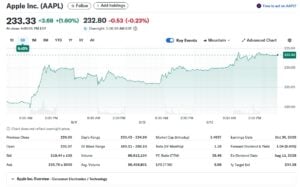
Let’s dive deeper into this:
$100 Billion Boost to American Manufacturing
Apple recently pledged an additional $100 billion to expand its U.S. manufacturing footprint, raising its total four-year American Manufacturing Program commitment to $600 billion. This plan includes opening new plants, offering supplier grants, and forming partnerships for key components like glass and chips.
The move is seen as a direct response to trade tensions with Washington, particularly past threats from President Donald Trump to impose a 25% tariff if iPhones weren’t made in the U.S. By increasing domestic production, Apple is improving its standing with policymakers and reducing the risk of costly import tariffs.
Key Partnerships Strengthen U.S. Supply Chain
As per media reports, the manufacturing expansion covers a broad network of U.S.-based suppliers and partners:
- Corning (GLW): Expanding smartphone glass production in Kentucky.
- Coherent (COHR): Producing VCSEL lasers for Face ID in Texas.
- TSMC, GlobalFoundries (GFS), and Texas Instruments (TXN): Collaborating on semiconductor production across Arizona, New York, Utah, and Texas.
- GlobalFoundries: Manufacturing wireless charging tech in New York.
Apple says this reshoring effort will enable an “end-to-end” chipmaking process in the U.S., from wafers to finished semiconductors. Over 19 billion chips for Apple products will be made domestically this year.
Rare Earth Partnership with MP Materials
Apple is also investing $500 million in MP Materials (NYSE: MP) to secure a long-term supply of rare earth magnets made entirely from recycled materials. These will be processed and manufactured in the U.S., supporting both supply chain resilience and Apple’s environmental commitments.
Apple’s Strong Earnings Fuel Investor Optimism
Apple’s latest earnings report added fuel to the rally. The company posted record June-quarter revenue of $94 billion—up 10% year over year. Product sales hit $66.6 billion, led by strong demand for the new iPhone 16 lineup and Mac computers.
Services revenue rose 13% to $27.4 billion, showing the company’s ability to diversify beyond hardware and generate steady, high-margin income.
- MORE DETAILS: Apple (AAPL Stock) Rings Up $94B Q3 Win Fueled by iPhones, AI Push, and Climate Smarts
Sustainability at the Core of Apple Products
Apple’s stock story also has a purpose. As per its latest sustainability report, in 2024, 24% of all product materials came from recycled or renewable sources, including:
- 99% recycled rare earth elements in magnets
- 99% recycled cobalt in batteries
- 100% recycled aluminum in many cases
Apple avoided 41 million metric tons of greenhouse gas emissions in 2024—equal to taking 9 million cars off the road. The company aims for a 75% emissions reduction from 2015 levels.
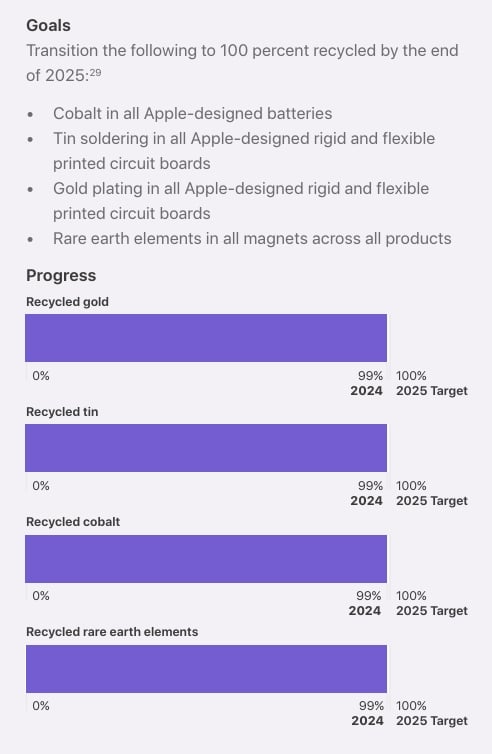
AI Partnerships Could Add Another Growth Driver
Reports suggest Apple is exploring partnerships with OpenAI and Anthropic to enhance Siri. If successful, these deals could strengthen Apple’s position in the fast-growing AI market.
Can U.S. Manufacturing Plans Keep the Rally Going?
Apple’s reshoring strategy could sustain momentum over the medium term. By resonating with Trump’s “America First” policies and reducing reliance on overseas suppliers, the company is lowering regulatory risks and earning political goodwill.
Nonetheless, challenges remain, but the long-term benefits could outweigh them by securing a more resilient supply chain.
From this analysis, it’s evident that Apple’s recent gains reflect a powerful combination of U.S. manufacturing investments, record earnings, sustainability leadership, and potential AI growth. By strategically aligning with domestic policy and building a stronger supply chain, the company is reducing uncertainty, which is one of the biggest drivers of investor confidence.
The post Apple: $94 Billion Record Earnings and the Breakthrough Climate Solutions Fueling Growth appeared first on Carbon Credits.
Carbon Footprint
U.S. DOE Reveals $1B Funding to Boost Critical Minerals Supply Chain
The U.S. Department of Energy (DOE) has announced a nearly $1 billion program to strengthen America’s supply of critical minerals and materials. The funding will support mining, processing, and manufacturing within the country. These materials power clean energy technologies and are vital for national security.
This funding builds on President Trump’s Executive Order to Unleash American Energy. It also supports the DOE’s wider Critical Minerals and Materials Program, which focuses on boosting U.S. production, expanding recycling, and strengthening supply chain security.
U.S. Secretary of Energy Chris Wright remarked:
“For too long, the United States has relied on foreign actors to supply and process the critical materials that are essential to modern life and our national security. Thanks to President Trump’s leadership, the Energy Department will play a leading role in reshoring the processing of critical materials and expanding our domestic supply of these indispensable resources.”
From Mines to Magnets: Where the $1B Goes
The DOE’s $1 billion plan targets key minerals like lithium, cobalt, nickel, and rare earth elements. These are essential for electric vehicle batteries, wind turbines, solar panels, and advanced electronics used in defense systems.
The funding is split across several areas:
- $500 million to the Office of Manufacturing and Energy Supply Chains (MESC) for battery material processing, manufacturing, and recycling projects.
- $250 million to the Office of Fossil Energy and Carbon Management to support facilities producing mineral byproducts from coal and other sources.
- $135 million to boost rare earth element production by extracting them from mining waste streams.
- $50 million to refine materials like gallium, germanium, and silicon carbide, which are crucial for semiconductors and high-performance electronics.
- $40 million through ARPA-E’s RECOVER program to extract minerals from industrial wastewater and other waste streams.
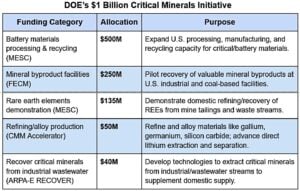
By investing from extraction to refining, the DOE aims to reduce reliance on foreign suppliers, especially those in politically unstable regions. The plan also encourages public–private partnerships to scale production faster.
Why Critical Minerals Matter for America’s Future
Critical minerals lie at the heart of America’s economic transformation and defense strategy. In recent years, demand for lithium, cobalt, nickel, and rare earth elements has grown. This rise comes as clean energy technologies become more important.
The U.S. imports more than 80% of its rare earth elements, and most of this comes from one country – China. This heavy reliance creates risks during trade or geopolitical tensions.
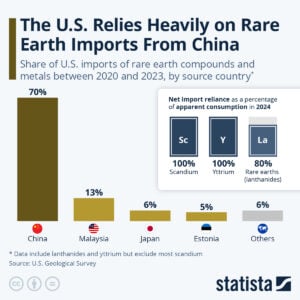
The Trump administration has placed strong emphasis on closing this vulnerability. In March 2025, an executive order highlighted critical minerals as vital for national defense. It also set timelines to boost U.S. production and processing capacity. This aligns with broader economic priorities, including clean energy jobs, green infrastructure, and domestic manufacturing.
The Inflation Reduction Act and infrastructure programs have unlocked billions in grants and tax credits. These funds support electric vehicle manufacturing, battery plants, and renewable energy projects.
The DOE’s $1 billion critical mineral fund supports programs by focusing on materials essential for the clean energy economy. Also, by reusing existing industrial facilities to recover minerals instead of building entirely new ones, the DOE can speed up progress and reduce costs.
EV production is expected to grow faster than any other sector, with demand for minerals likely to be more than 10x higher by 2050. This surge will transform the global supply chain and is critical for the global Net Zero aspirations.
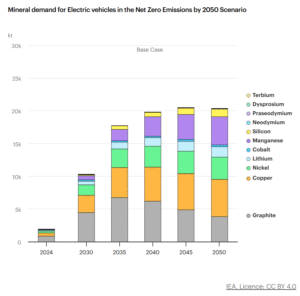
The combined impact of industrial strategy, financial incentives, and supply chain investments shows a clear push to:
- Move production back onshore,
- Boost innovation in materials recycling,
- Support the energy transition, and
- Cut down on foreign imports.
Building on Early Wins
The DOE’s new $1 billion investment boosts earlier funding for critical minerals. This aims to strengthen U.S. industrial capacity.
In 2023, the Department gave $150 million to various clean mineral projects. These include direct lithium extraction in Nevada and early-stage nickel processing partnerships in Oregon.
Since 2021, DOE has invested more than $58 million in research. This work focuses on recovering critical minerals from industrial waste or tailings. They are turning by-products into valuable feedstock.
These R&D projects created pilot facilities. They show how to recover lithium from geothermal brines and rare earths from coal ash. This approach models resource use without needing new mining.
Built on these early successes, the new $1 billion fund signals a shift from pilot programs to scaling proven technologies. It allows U.S. manufacturers to pivot from lab-scale experiments to full commercial operations.
For example, lithium recovery projects are moving from test sites to large extraction facilities. This shift is supported by the technical help from DOE’s national labs.
Likewise, battery recycling pilots are set to grow. More recycling centers are being planned in the Midwest and Southwest.
This funding approach provides continuity. It supports U.S. firms from basic research to commercialization. This helps them quickly move from proof-of-concept to production-ready operations. It also reassures private investors that government backing is strategic and sustained.
McKinsey projects that developing new copper and nickel projects will require between $250 billion and $350 billion by 2030. By 2050, the broader critical minerals sector could grow into a trillion-dollar market to support the net-zero or low-carbon transition.

Washington’s Backing, Industry’s Buy-In
Political backing for the domestic minerals strategy is strong. A recent executive order aims to speed up mining permits and provide federal support.
The Defense Department has also invested $400 million in MP Materials, the largest stakeholder in the only U.S. rare earth mine. This deal includes a new plant to produce magnets for electronics and defense applications.
Industry players are moving in the same direction. Battery maker Clarios is exploring sites for a $1 billion processing and recovery plant in the country. These moves show a shared goal between government and industry to rebuild America’s mineral supply chains.
Opportunities—and the Roadblocks Ahead
The DOE’s program offers major opportunities:
- Less reliance on foreign countries for essential materials.
- Creation of high-quality U.S. jobs.
- Growth in recycling and recovery technologies.
However, challenges remain. Mining and processing must be done without harming the environment. Technology costs need to stay competitive. And benefits must be shared fairly with local and Indigenous communities.
Amid all this, the global race for critical minerals is intensifying. Many countries are already securing their own supplies. The U.S. wants to close its supply gap and become a leader in clean energy manufacturing.
The DOE’s nearly $1 billion plan is a key step toward reshoring America’s critical minerals industry. It builds on earlier successes and aligns with private investments and new policies. If successful, it could make U.S. supply chains more secure, support the clean energy transition, and strengthen national security.
The post U.S. DOE Reveals $1B Funding to Boost Critical Minerals Supply Chain appeared first on Carbon Credits.
Carbon Footprint
Bitcoin Price Hits $124,000 Record High vs Ethereum Price Near $4,800: Which Crypto Is Greener?
Bitcoin price surged past $124,000 upon writing, setting a new all-time high. Analysts credit several factors:
- strong institutional buying,
- increased inflows into Bitcoin ETFs,
- favorable regulatory changes allowing crypto assets in 401(k) retirement accounts, and
- growing market optimism over expected Federal Reserve interest rate cuts.
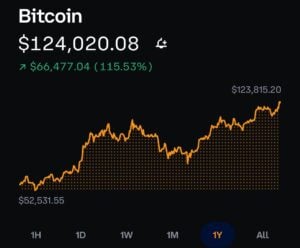
The rally reflects both a recovery from previous market downturns and a renewed appetite for digital assets among mainstream investors.
Ethereum, the second-largest cryptocurrency by market capitalization, is also on the rise. It is now approaching its all-time high of around $4,800, last seen in November 2021.
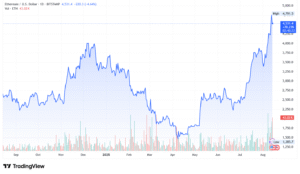
Investor sentiment is rising because of Ethereum’s role in decentralized finance (DeFi) and NFT marketplaces. Its better environmental profile, thanks to the switch to a proof-of-stake (PoS) model, also helps.
With both tokens in focus, let’s look at their energy use and carbon footprint. This matters for investors and policymakers who care about their climate and environmental impact.
How Bitcoin’s Proof-of-Work Consumes Energy
Bitcoin’s network runs on a process called proof-of-work (PoW). Miners around the world compete to solve complex mathematical puzzles. The first to solve it gets to add a block of transactions to the blockchain and earn newly minted Bitcoin. This process secures the network but demands enormous computing power.
That computing power uses a lot of electricity. Bitcoin’s annual energy use is estimated at about 138–178 terawatt-hours (TWh). This is similar to the electricity consumption of countries like Poland or Thailand, and even greater than Norway.
The carbon footprint is equally large, at around 40 million tonnes of CO₂ equivalent per year. To put that into perspective, that’s similar to the emissions of Greece or Switzerland.
On a per-transaction basis, a single Bitcoin payment can use as much energy as a typical U.S. household does in one to two months.
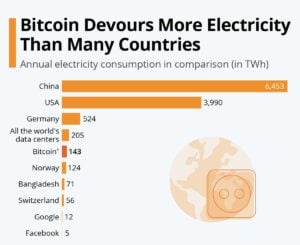
Beyond electricity, Bitcoin mining also generates significant electronic waste. Specialized mining hardware, called ASICs, becomes obsolete quickly—often within two to three years—because faster, more efficient models keep being developed. This turnover contributes thousands of tonnes of e-waste annually.
Ethereum’s Post-Merge Energy Transformation
Before 2022, Ethereum also used proof-of-work, with high energy demands. But in September 2022, the network completed the Merge, switching to proof-of-stake.
Ethereum now uses validators instead of miners. These validators “stake” their ETH tokens as collateral. This helps confirm transactions and secure the network.
This change cut Ethereum’s energy use by over 99.9%. Today, the network consumes an estimated 2,600 megawatt-hours (MWh) annually—roughly 0.0026 TWh. That’s less electricity than a small town of 2,000 homes might use in a year.
The carbon footprint is also tiny compared to Bitcoin—under 870 tonnes of CO₂ equivalent annually. That’s about the same as the yearly emissions of 100 average U.S. households. In environmental terms, Ethereum has gone from being one of the largest blockchain energy consumers to one of the most efficient.

Beyond Electricity: Hidden Environmental Costs
While electricity use is the biggest factor, it’s not the only environmental concern for both cryptocurrencies. Here are the other environmental impacts:
- Water Use:
Large-scale Bitcoin mining facilities often require substantial cooling, which can consume millions of liters of water annually. This can put pressure on local water supplies, particularly in drought-prone regions. Ethereum’s low energy profile greatly reduces such needs. - Heat Output:
Mining facilities generate significant heat. In some cases, waste heat is reused for industrial or agricultural purposes, but in most situations, it is simply released into the environment, adding to local thermal loads. - Land and Infrastructure:
Bitcoin mining operations require large warehouses and access to high-capacity electrical infrastructure. This can limit available industrial space for other uses and put stress on local grids.
By using proof-of-stake, Ethereum avoids most of these impacts. It just needs standard server equipment. This can run in data centers with other low-impact computing tasks.

How the Industry Is Addressing Bitcoin’s Footprint
The crypto industry is aware of Bitcoin’s environmental challenges and is taking steps to address them. Some of the actions taken include:
- Renewable Mining: Some mining operations use only hydro, wind, or solar energy. This is common in areas with plenty of renewable resources.
- Waste Heat Recovery: A few miners capture and reuse waste heat for agriculture (e.g., greenhouse farming) or district heating systems.
- Carbon Offsetting: Companies and mining pools are buying carbon credits to offset emissions. However, how well this works depends on the quality of those credits.
- Policy Proposals: Governments may require Bitcoin miners to share their energy sources or meet renewable energy goals.
SEE MORE: Top 5 Sustainable Bitcoin Mining Companies To Watch Out For
While these efforts are promising, the core challenge remains: proof-of-work’s high energy requirement is built into Bitcoin’s security model.
Why This Matters for ESG-Minded Investors
For investors who care about environmental, social, and governance (ESG) factors, the difference between Bitcoin and Ethereum is stark. Ethereum’s low-energy proof-of-stake model makes it easier to align with climate goals. Bitcoin’s high energy use and emissions, while partially mitigated by renewable adoption, remain a significant concern.
These factors may influence where ESG-focused funds allocate capital. Companies and institutions wanting exposure to blockchain technology without a large carbon footprint might prefer Ethereum or other PoS networks.
Bitcoin may still attract investors because of its market dominance and value as a store. However, it will likely keep facing environmental concerns.
The Road Ahead for Crypto and Climate
Bitcoin and Ethereum’s price rallies show that investor interest in crypto remains strong. As climate change and sustainability gain importance in policy and investment, environmental performance may play a larger role in the long-term value and acceptance of digital assets.
For now, Ethereum sets the standard for energy efficiency among major blockchains, while Bitcoin represents the ongoing challenge of balancing security, decentralization, and sustainability. Can Bitcoin cut its environmental impact without losing its key features? This will be an important question in the coming years.
The post Bitcoin Price Hits $124,000 Record High vs Ethereum Price Near $4,800: Which Crypto Is Greener? appeared first on Carbon Credits.
-
Climate Change2 years ago
Spanish-language misinformation on renewable energy spreads online, report shows
-
Climate Change Videos2 years ago
The toxic gas flares fuelling Nigeria’s climate change – BBC News
-

 Greenhouse Gases1 year ago
Greenhouse Gases1 year ago嘉宾来稿:满足中国增长的用电需求 光伏加储能“比新建煤电更实惠”
-

 Climate Change1 year ago
Climate Change1 year ago嘉宾来稿:满足中国增长的用电需求 光伏加储能“比新建煤电更实惠”
-

 Carbon Footprint1 year ago
Carbon Footprint1 year agoUS SEC’s Climate Disclosure Rules Spur Renewed Interest in Carbon Credits
-
Climate Change2 years ago
Why airlines are perfect targets for anti-greenwashing legal action
-
Climate Change Videos2 years ago
The toxic gas flares fuelling Nigeria’s climate change – BBC News
-
Climate Change2 years ago
Some firms unaware of England’s new single-use plastic ban



